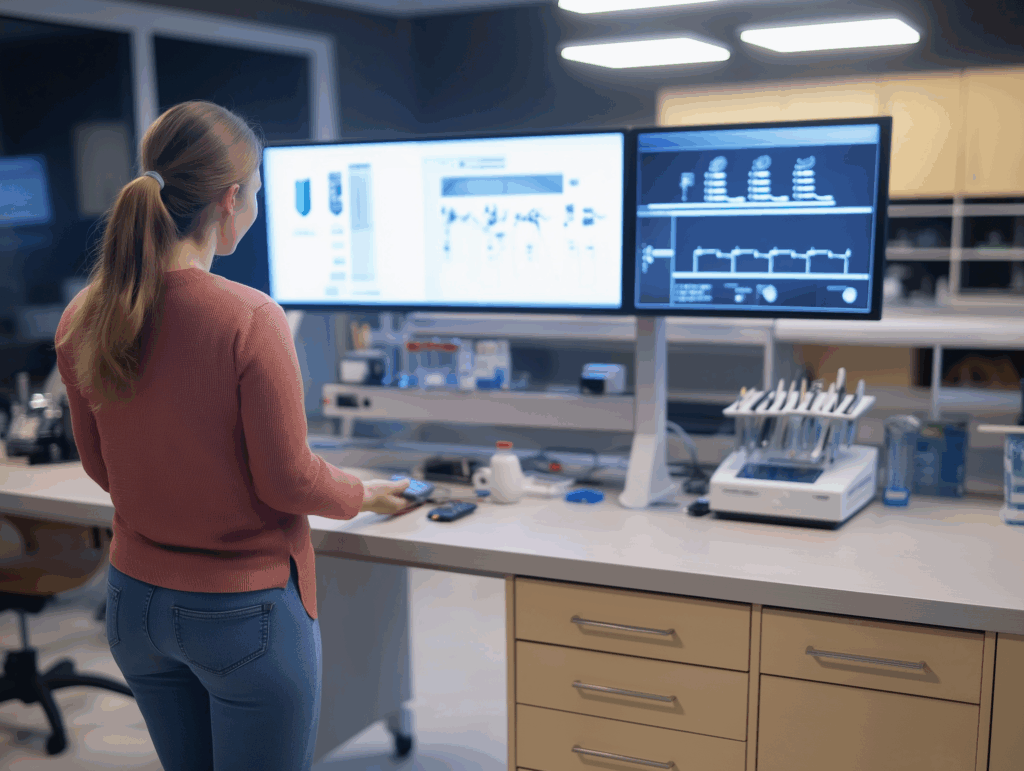Note: This is a hypothetical application example. Some details of B&W Engineering’s customer projects have been changed for confidentiality reasons. However, the content described reflects our actual approach and expertise.
A fictional success story.
Let’s assume a customer wants to develop a portable device that monitors vital signs such as heart rate and oxygen saturation around the clock. We would deploy an interdisciplinary team of electronics, software, mechanical, and medical technology experts to develop a well-founded feasibility study within ten weeks.
The approach would focus on the following key areas:
Profile.
Development process
Challenge
- Medical technology compliance.
- User-friendly and convenient.
- Reliable sensor technology, signal processing, and stable wireless connection.
- Identify and manage risks early on.
Solutions
- Thorough analysis of target groups, wearing comfort, data security, and regulatory framework conditions.
- Creation of detailed specifications (including measurement accuracy, interfaces such as Bluetooth LE, water resistance).
- Sensory tests (PPG, ECG) under realistic conditions.
- Development of algorithms for filtering and evaluating vital data.
- Energy analysis: consumption planning, intelligent energy-saving modes.
- Radio technology: selection, prototyping, and stability tests (especially Bluetooth LE).
- Material and component selection.
Result
- Validated specifications and tested technical concepts.
- Comprehensive risk analysis with documented countermeasures.
- A reliable basis for decision-making for the next project phase.
In detail.
Requirements analysis and specification
The project would begin with a thorough requirements analysis. We would record all user needs and regulatory requirements in order to create a solid foundation:
- User needs and application scenarios: For example, target groups would be defined, vital parameters to be measured would be specified, and requirements for wearing comfort, battery life, and data display would be determined. Data protection and usability aspects (ease of use for the end user) would also be taken into account.
- Regulatory requirements (MDR, ISO 13485, IEC 60601): The medical device class that the wearable is likely to fall into and the applicable standards and regulations would be examined at an early stage. We would ensure compliance with the EU Medical Device Regulation (MDR) and that development takes place within the framework of an ISO 13485-compliant quality management system. Safety requirements such as IEC 60601 (electrical safety and basic performance of medical devices) would be included as early as the specification phase.
- Product specification: Based on these requirements, a detailed specification sheet would be created. This would include all functional and non-functional requirements – from measurement accuracy and interfaces (e.g., Bluetooth Low Energy) to environmental conditions (such as water resistance) and maintenance concepts. This specification would serve as a guide for all further steps.
Technological feasibility studies
Parallel to the requirements analysis, technical feasibility studies would be carried out in key areas to validate the selected solutions. Our team could set up initial trials and prototypes in short iterations to address technical risks at an early stage:
- Sensors: Suitable sensors for continuous vital data recording would be evaluated. For example, we could consider optical PPG sensors for pulse and oxygen or electrodes for an ECG. Laboratory tests would be conducted to determine whether these sensors provide reliable signals under realistic conditions (movement, different skin types).
- Signal processing: The experts would develop algorithms and filters to calculate meaningful vital signs from the raw data. Any interference signals (motion artifacts, electrical noise) would be simulated and addressed with signal processing techniques. We would possibly create initial software prototypes to analyze heart rate variability and test alarm criteria, for example.
- Power supply: One focus would be the analysis of power requirements. A detailed power consumption plan would be created for all components in order to estimate the required battery capacity. We would check whether a miniature battery would provide sufficient runtime (e.g., 24 hours) and how intelligent energy-saving modes could extend the operating time.
- Wireless technologies: B&W would select the appropriate wireless technology and test it in a test setup. Typically, Bluetooth Low Energy would be used to continuously transmit data to a smartphone app or cloud. This would involve checking that the connection is stable and energy-efficient and that it meets the requirements of radio approvals. Alternatively, depending on the use case, other transmission methods (e.g., Wi-Fi) could also be considered.
These parallel feasibility studies would provide the team with reliable data and insights after just a few weeks, showing which technical concepts are viable and where adjustments may be necessary.
Early in the project, we would conduct a systematic risk analysis in accordance with the medical technology standard ISO 14971. Typical risks associated with the wearable would be identified, evaluated, and examined in detail using failure mode and effects analysis in order to derive appropriate countermeasures:
- One possible risk would be that the sensor provides unreliable values (e.g., due to slipping on the wrist or extreme movements). This would be included in the FMEA as a potential error case. Countermeasures could include calibration routines, intelligent signal filtering, or redundant sensors (second sensor for plausibility checks) to increase the reliability of the vital data.
- The use of a lithium-ion battery carries risks such as overheating or deep discharge. We would provide appropriate protective circuits and temperature sensors to prevent overload. The risk analysis would assess which faults (e.g., defect in the charging circuit) could lead to overheating, and safety mechanisms would be planned (such as shutdown in case of overtemperature).
- Since the device is designed to monitor continuously, there is a risk that important data could be lost in the event of radio interruptions or software errors. We would plan measures for this, e.g., a buffer memory in the device that temporarily stores data, as well as signaling to the user if the connection is interrupted. Cybersecurity aspects (protection against unauthorized access to vital data) would also be considered in the risk analysis, and appropriate encryption and authentication measures would be provided for.
All identified risks would be assessed according to their probability of occurrence and severity. This would enable our team to prioritize which risks must be eliminated or reduced. This proactive approach would ensure that no critical unknown risks remain at the end of the feasibility phase. The results of the risk analysis and FMEA would also lay the foundation for the necessary documentation in a later approval process.
- Biocompatibility: Since the device would be worn directly on the skin, all materials that come into contact with the skin (housing, wristband, electrodes) would have to be biocompatible and hypoallergenic. B&W would suggest materials that comply with the relevant standards (e.g., ISO 10993 for biological evaluation) to avoid skin irritation or allergic reactions. For example, medical-grade silicones or special plastics that are sweat- and water-resistant would be used.
- Miniaturization: To ensure a high level of comfort, the electronics would have to be as small and light as possible. Our developers would select components with a high integration density—such as a system-on-chip that combines microcontrollers and sensors—and design a space-optimized circuit board. The mechanical and electronics teams would work closely together to accommodate all components (sensors, battery, antenna) in a compact, ergonomic housing. Modern rapid prototyping methods (e.g., 3D printing for housing samples) could be used to test the design at an early stage.
- Charging infrastructure: Even in the concept phase, our team would consider how the wearable could be conveniently charged by the user. One option would be a wireless charging function (inductive charging), which would allow for a completely closed, waterproof housing. Alternatively, a magnetic docking station could be designed to charge the device securely in a short time. The choice of charging technology would be based on criteria such as user-friendliness, charging time, connection tightness, and battery life. The charging solution would also be tested to ensure that it meets the relevant safety standards.
Results after approx. 5-8 weeks …
At the end of the ten-week project phase, B&W Engineering would have a comprehensive feasibility study. This would include clear specifications, test results from the feasibility studies, a detailed risk report, and recommended materials and components. Our hypothetical customer would then have a solid basis for deciding whether to move the project on to the next phase.











